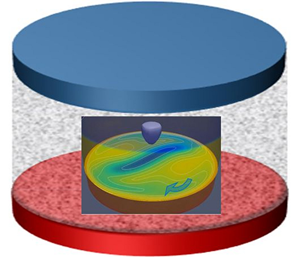Article contents
Effect of heat transfer through an interface on convective melting dynamics of phase change materials
Published online by Cambridge University Press: 10 July 2023
Abstract

The presence of thermocapillary (Marangoni) convection in microgravity may help to enhance the heat transfer rate of phase change materials (PCMs) in space applications. We present a three-dimensional numerical investigation of the nonlinear dynamics of a melting PCM placed in a cylindrical container filled with n-octadecane and surrounded by passive air. The heat exchange between the PCM and ambient air is characterized in terms of the Biot number, when the air temperature has a linear profile. The effect of thermocapillary convection on heat transfer and the topology of the melting front is studied by varying the applied temperature difference between the circular supports and the heat transfer through the interface. The evolution of Marangoni convection during the PCM melting leads to the appearance of hydrothermal instabilities. A new mathematical approach for the nonlinear analysis of emerging hydrothermal waves (HTWs) is suggested. Being applied for the first time to the examination of PCMs, this procedure allows us to explore the nature of the coupling between HTWs and heat gain/loss through the interface, and how it changes over time. We observe a variety of dynamics, including standing and travelling waves, and determine their dominant and secondary azimuthal wavenumbers. Coexistence of multiple travelling waves with different wavenumbers, rotating in the same or opposite directions, is among the most fascinating observations.
- Type
- JFM Papers
- Information
- Copyright
- © The Author(s), 2023. Published by Cambridge University Press
References
Šeta et al. Supplementary Movie 1
- 10
- Cited by



